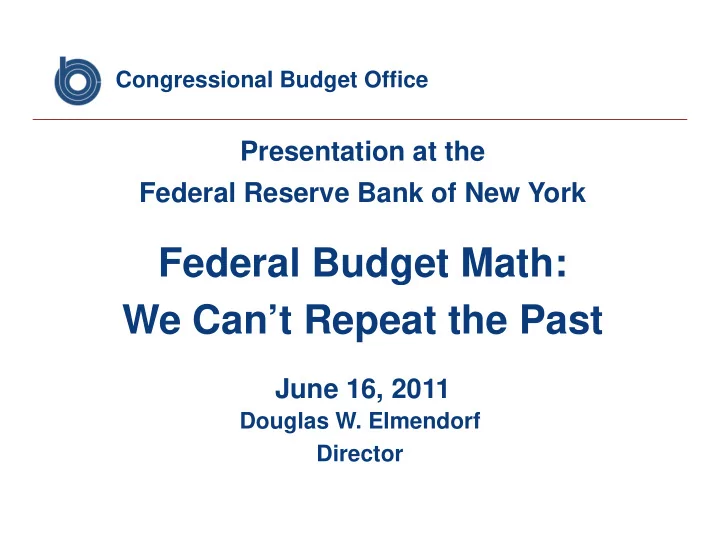

Congressional Budget Office Presentation at the Federal Reserve Bank of New York Federal Budget Math: Federal Budget Math: We Can’t Repeat the Past June 16, 2011 Douglas W. Elmendorf Director
Total Federal Deficits and Surpluses Percentage of GDP 4 4 Actual Projected 2 2 0 0 -2 -2 Baseline -4 -4 -6 -6 Continuation of Certain Policies -8 -8 -10 -10 -12 -12 1971 1976 1981 1986 1991 1996 2001 2006 2011 2016 2021 2
Federal Debt Held by the Public Percentage of GDP 120 120 Actual Projected Continuation 100 100 of Certain Policies 80 80 Baseline Baseline 60 60 40 40 20 20 0 0 1940 1949 1958 1967 1976 1985 1994 2003 2012 2021 3
Key Aspects of Federal Budget Policy during the Past 40 Years � Revenues have averaged about 18 percent of GDP, with substantial variation around that level but no trend. � Older Americans have received: – Cash payments that have risen with average wages (through Social Security), – Health insurance with a significant defined-benefit subsidy (through Medicare), and – Additional subsidies for health insurance and subsidized long- term care (through Medicaid) for many of those with very high medical costs or little income and assets. � Defense spending has trended down relative to GDP. � Outlays for all other federal programs have shown substantial variation relative to GDP and a slight downward trend. 4
Total Federal Revenues Percentage of GDP 24 24 Actual Baseline Projection 22 22 20 20 18 18 Average Revenues, 1971 to 2010 16 16 14 14 0 0 1971 1976 1981 1986 1991 1996 2001 2006 2011 2016 2021 5
Average Federal Tax Rates by Quintile Percent 30 Highest Quintile 25 20 Fourth Quintile Middle Quintile 15 Second Quintile 10 5 Lowest Quintile 0 1971 1974 1977 1980 1983 1986 1989 1992 1995 1998 2001 2004 2007 2010 6
Outlays for Social Security and Major Health Care Programs Percentage of GDP 6 Actual Baseline Projection 5 Social Security 4 3 Medicare 2 1 Medicaid, CHIP, and Exchange Subsidies 0 1971 1976 1981 1986 1991 1996 2001 2006 2011 2016 2021 7
Other Components of Federal Spending Percentage of GDP 8 Actual Baseline Projection 7 Defense Discretionary 6 5 Non-Defense Discretionary 4 3 Mandatory Spending Other Than 2 Social Security, Medicare, Medicaid, CHIP, and Exchange Subsidies 1 0 1971 1976 1981 1986 1991 1996 2001 2006 2011 2016 2021 8
Federal Employees Millions Percent 8 12 7 10 Number of 6 Federal Employees (left axis) 8 5 4 6 3 4 Federal Employees as a Share of the Total Workforce 2 (right axis) 2 1 0 0 1971 1974 1977 1980 1983 1986 1989 1992 1995 1998 2001 2004 2007 2010 9
Shares of Federal Spending in 2010 Percent Transfer payments to people in the United States 47 Grants to state and local governments Grants to state and local governments 14 14 Purchases of goods and services for defense 19 9 Purchases of goods and services for nondefense Interest 8 Other (includes transfers to people outside the U.S.) 4 Source: National Income and Product Accounts. 10
Trends in Federal Spending during the Past 40 Years � The costs of Social Security, Medicare, Medicaid, and the Children’s Health Insurance Program have risen substantially relative to GDP, from 4.3 percent in 1971 to 8.7 percent in 2007 (before the recession). � Defense spending has fallen substantially relative to GDP, from 7.3 percent in 1971 to 3.9 percent in 2007. 11
We Cannot Repeat the Past in the Federal Budget Given the aging of the population and the rising cost of health care, the United States cannot achieve all of the following objectives in the future: � Keep federal revenues at their average share of GDP during the past 40 years. during the past 40 years. � Provide the same sorts of benefits for older Americans that we have provided in the past 40 years. � Operate the rest of the federal government in line with its role in the economy and society during the past 40 years. 12
Components of the Federal Budget (percentage of GDP) 2021 2021 2022 1971-2010 March President’s Ryan Average Baseline Budget Proposal Projection Estimate Estimate Revenues 18.0 20.8 19.3 18 1/2 20.8 23.9 24.2 20 1/4 Outlays 18.6 20.5 20.3 17 Noninterest outlays Interest 2.2 3.4 3.9 3 1/4 Deficit 2.8 3.1 4.9 2 Note: The Ryan proposal was estimated relative to an earlier baseline, so the figures are not precisely comparable to the latest baseline projection or estimates for the President’s budget. 13
Noninterest Outlays (percentage of GDP) 2021 2021 2022 1971-2010 March President’s Ryan Average Baseline Budget Proposal Projection Estimate Estimate Noninterest Outlays 18.6 20.5 20.3 17 Social Security Social Security 4.3 4.3 5.3 5.3 5.3 5.3 5 1/4 5 1/4 Major health programs 2.9 6.9 7.1 5 1/2 Defense 4.8 3.6 3.1 } 6 Other mandatory spending and nondefense discretionary 6.7 4.6 4.8 spending Note: Major health programs include Medicare, Medicaid, the Children’s Health Insurance Program, and exchange subsidies. The Ryan proposal was estimated relative to an earlier baseline, so the figures are not precisely comparable to the latest baseline projection or estimates for the President’s budget. 14
Outlays for Major Programs Compared with Total Revenues Under a Continuation of Certain Policies Percentage of GDP 22 Actual Projected Outlays for Social Security, Major Health Programs, 20 Defense, and Net Interest 18 Total Revenues 16 14 0 2008 2009 2010 2011 2012 2013 2014 2015 2016 2017 2018 2019 2020 2021 15
The Choices Confronting Policymakers � The question is not whether to change current policies, but when and in what ways. � There are trade-offs regarding the timing of implementing policy changes, but there are important benefits and few apparent costs to deciding about those changes soon. � Fiscal policy cannot be put on a sustainable path just by eliminating waste and inefficiency; instead, changes will need to significantly affect popular programs, people’s tax payments, or both. 16
Recommend
More recommend